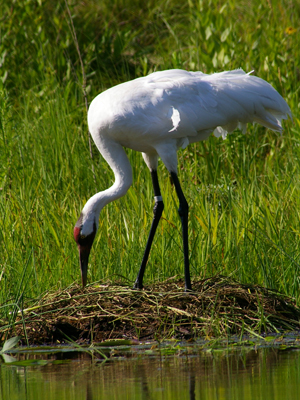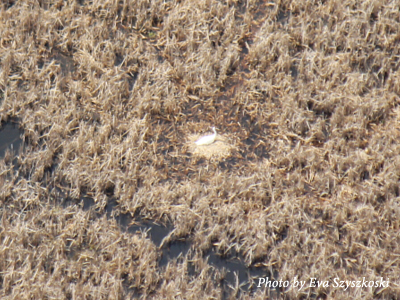 We stole 15 Whooping Crane eggs. But don’t worry! It’s all part of a science-based strategy to increase the number of Whooping Cranes above their current world population of just 600 birds. And, so far, the results are looking good.
We stole 15 Whooping Crane eggs. But don’t worry! It’s all part of a science-based strategy to increase the number of Whooping Cranes above their current world population of just 600 birds. And, so far, the results are looking good.
Our Whooping Cranes flock typically does not lay 15 eggs in a day (one to three is much more usual), but we recently received 15 eggs from our Wisconsin neighbors at the Necedah National Wildlife Refuge. Once the refuge staff transferred the eggs to our headquarters, we quickly settled the precious eggs in incubators. We have assessed the fertility and viability of each egg and today are sending 14 fertile eggs that got a “thumbs up” to our partners at the Patuxent Wildlife Research Center in Maryland. There, they will continue incubating the eggs, and the resulting chicks will likely be prepared for release, either through the ultralight-reintroduction method here in Wisconsin or in Louisiana.
We are guessing that you are thinking, “Why did you remove these eggs from their nests in the wild?” First a little background information:
It’s a simple math problem, really. Whooping Cranes will lay two eggs in a clutch, the second following about a day after the other. In the wild, if the eggs are not fertile or the pair loses their eggs to a predator or another event, they may re-nest. In captivity, we utilize this natural process to increase the number of eggs that a pair lays for the good of the species. We will often pull the eggs from the nest as they are laid. Next, we place the eggs in an incubator, or even under another surrogate crane pair, to finish their development. The original parents – acting on instinct developed over generations – will lay two more eggs. This way, instead of just two eggs from a single pair, we can get four, six, even up to eight or ten.
In 2001 the first Whooping Cranes were reintroduced to their historic breeding grounds in Wisconsin through the efforts of the Whooping Crane Eastern Partnership. After five years, the first pairs began nesting, with the first chick successfully hatching in 2006. The number of nesting attempts have gradually increased since that first year, with 28 nesting attempts in 2014. The problem? Most of the first nests are abandoned – likely due to the hatching of blackflies, a small parasitic fly that torments the birds while they are incubating and forces them to abandon their nests.
 To address this issue, we are looking at whether we can change the timing of the cranes’ nesting through a “forced re-nesting” study. The idea is that by taking the eggs from the bird’s first nests in mid-April when the blackfly hatch is at its peak, this will stimulate the birds to re-nest and lay a second clutch that is a bit later, following the blackfly hatching. If there are fewer blackflies, then we theorize that the cranes will stay on their nests longer, successfully incubating their eggs, and hatching out healthy chicks. We will monitor the cranes to see if their re-nests are successful and continue developing the science to achieve our shared goal: protecting Whooping Cranes from the threat of extinction.
To address this issue, we are looking at whether we can change the timing of the cranes’ nesting through a “forced re-nesting” study. The idea is that by taking the eggs from the bird’s first nests in mid-April when the blackfly hatch is at its peak, this will stimulate the birds to re-nest and lay a second clutch that is a bit later, following the blackfly hatching. If there are fewer blackflies, then we theorize that the cranes will stay on their nests longer, successfully incubating their eggs, and hatching out healthy chicks. We will monitor the cranes to see if their re-nests are successful and continue developing the science to achieve our shared goal: protecting Whooping Cranes from the threat of extinction.
It’s because of your support that we can continue to lead Whooping Crane conservation efforts, and for that – we thank you!
Keep posted on the latest Whooping Crane developments by following us on Facebook and Twitter!
